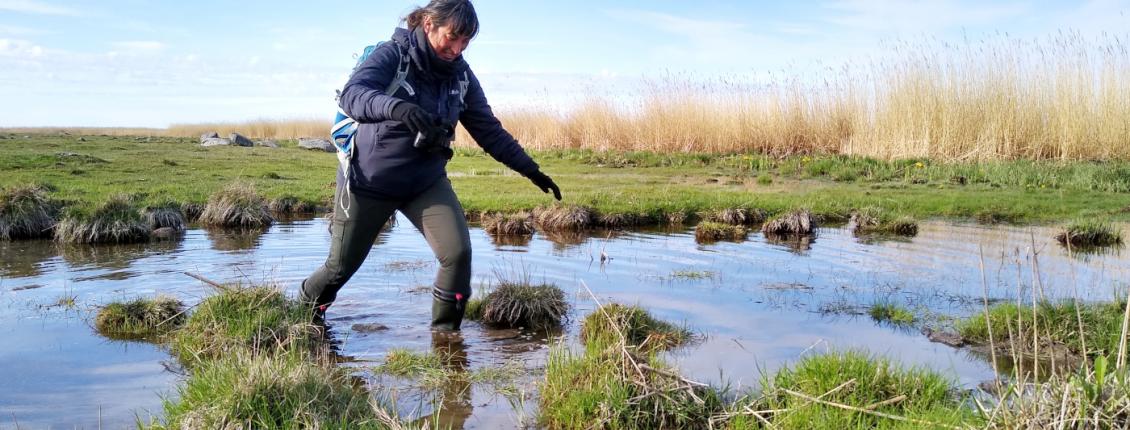July 9, 2025
Kaidi Tingas
The keywords to look out for in the monitoring of the hatching success rate of meadow waders in 2025 are ‘fox dens’
The Nature Conservation Biology Working Group of the University of Tartu also monitored the hatching success rate of waders nesting in coastal meadows this year. The results of the monitoring show that foxes inhabiting the coastal meadows and their burrows were the main issue for the year. A total of 178 dens were monitored.
Triin Kaasik, the working group’s lead ecologist, says that fox dens cannot be avoided under current hunting management and, to be more successful next season, a den hunt should be held at all known dens at the end of March, before the start of the breeding season for birds and foxes.
‘We are monitoring the bird population in both unrestored and restored areas. However, the predation pressure is currently so high that without the support of hunting we cannot expect to achieve good results in restored areas either,’ says Triin. She mentions the Aandi meadow, in Hiiu County, as an example. Each year there is less and less woody vegetation, which makes it an increasingly attractive habitat for birds. However, in the spring of 2025 there were two fox dens at each end of the meadow. As a result, the hatching success rate of the meadow waders was 0%. Only one pair remains! On a positive note, hunting has led to the hatching success rate in the Matsalu, Haeska, and Põgari-Sassi meadows being good for several years in a row.
Triin emphasises that the abundance of small predators we are seeing now is a consequence of the eradication of rabies. ‘We don’t want this disease to return; however, I believe it’s our responsibility to address the problem,’ she says.
Since cooperation with the Estonian Hunters’ Society for hunting small predators nesting in coastal areas has been going on for several years, the Hunters’ Society has also presented its own proposals for the future improvement of hunting. A meeting between the Society, the Ministry of Climate and the Environmental Board will take place in early autumn.
- Hunting societies operating in Baltic Dunlin nesting areas should conduct more intensive hunting of small wild game during the winter, not only in coastal meadows, but also further inland, in order to reduce the number of foxes, common raccoon dogs, European badgers, and jackals in general. Hunters could be motivated by the organisation of a collective small predator hunt.
- In late winter, specimens nesting in and around coastal meadows should be hunted and their burrows removed before the nesting period for foxes and European badgers begins, to prevent new specimens from moving in.
- In those areas, wherever possible, apply for hunting until 15 April. This practice is allowed by the Environmental Board, for example, on islets, where hunters go to hunt small predators immediately prior to the start of the bird nesting season. If this is possible on islets, why not use it to protect the rare Baltic dunlin on coastal meadows as well.
During the next monitoring period it would be interesting to learn if placing a focus on eliminating already existing burrows on coastal meadows led to an increase in breeding success.
Who are waders? Waders are migratory birds that only spend their nesting season in Estonia. It is here that they raise their chicks and by doing so also ensure the survival of the local population of the species; however, the situation is not praiseworthy – Baltic dunlins, ruffs, and common snipes have been listed as endangered species on the Estonian Red List.
What threatens waders? In addition to the reduction in open landscapes, the success of meadow waders is primarily affected by the plundering of nests. We are therefore monitoring the hatching rates of nests on coastal meadows. Alongside monitoring activities, the project will fund the seasonal hunting of small predators moving about on coastal meadows, as well as meadow restoration works, including felling forests that are not suitable for open landscapes.
What about the hunting of small predators associated with meadow waders? As the habitats of coastal meadow birds have become fragmented over the past 70 years, small mammalian predators can easily plunder the bird nests on the ground by moving along forest edges or juniper bushes. Even so, the abundance of prey and predators is due not only to changes in the landscape, but also to the fact that there are currently no significant factors limiting the populations of small predators.
